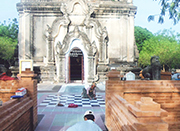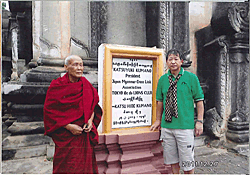アウンザブタイヤ寺院 JAPAN PAGODA ミャンマーの奇跡日本人(熊野活行)が救った301体の仏像写真集
はじめに
アウンザブタイヤ寺院は、ミャンマー連邦共和国のヤンゴン市マウビ・タウンシップにパナウンタ大僧正によって建立された寺院です。一般財団法人「日本ミャンマー友好交流協会」代表理事の熊野活行は2012年10月に世界最古級のものを含め、301体の古代仏像をアウンザブタイヤ寺院に寄贈しました。
ミャンマーの人々はこの寺院を、愛を込めて「ジャパン・パゴダ(日本の仏塔)」と呼んでいます。 本冊子は日本とミャンマーの友好の証として編纂したものです。今後も両国のさらなる相互交流、相互支援の発展を当協会では心より願っております。
一般財団法人 日本ミャンマー友好交流協会 代表理事 熊野活行
—
Chapter1
ミャンマーの旧首都であり、国内最大の都市ヤンゴン。その中心部から北東へ車で1時間半、マウビ・タウンシップにアウンザブタイヤ寺院はある。民家もまばらなこの集落に、週末になると国内外から5万人もの人々が押し寄せる。目的は世界最古級のものを含めた301体の仏像を参拝するためだ。
これら歴史的な仏像は本来、ここにあるはずではなかった。地下マーケットから非合法的に国外へ持ち出されるのを一人の日本人が救い出し、寄贈したのである。
国民の9割近くが仏教徒のミャンマーで、人々はこの寺院を、愛を込めてこう呼ぶ―「ジャパン・パゴダ(日本の仏塔)」と。
—
Chapter2
日本ミャンマー友好交流協会の代表理事・熊野活行が知人に誘われて、初めてミャンマーを訪れたのは2002年のことだった。先の戦争で多くの日本人が亡くなった地。日本人と同じ蒙古斑を持つ民族。血は水よりも濃し―熊野は言い知れぬ親しみをこの国の人々に抱いた。
同年、同協会を設立すると、毎月のようにミャンマーを訪れ、教育支援などを行うようになる。
そして、2005年、熊野は不思議な体験をする。<鬼>と出会ったのである。
—
Chapter3
古都バガンで現地の運転手が道に迷い、偶然たどり着いた薄暗い洞窟。微かな気配を感じ、暗がりの奥に視線を向けると、<鬼>が熊野を睨みつけていた。恐怖に体がすくみ、逃げるように立ち去った熊野は、日本に帰国してからも夢の中で、その<鬼>にうなされるようになる。
「後から調べると、あれは朽ち果てた、しかし由緒あるパゴダ(仏塔)だと分かりました。そして、よくよく考えると、あの<鬼>は仏像だったのです。毎晩同じ夢を見続ける中で仏像は恐ろしい形相ながらも、何かを私に伝えようとしているのではないか、そんなふうに思うようになりました」
熊野はこの不思議な夢を「パゴダを修復するように」というお告げだと理解する。そして、ミャンマーへ戻ると、朽ち果てたパゴダの修復を申し出たのであった。
—
Chapter4
当時のミャンマーでは各地の仏像が非合法的に中国やタイに持ち出されそうになっていた。軍政によって寄進とお布施を禁止された僧侶たちが貧苦に喘ぎ、やむなく仏像を地下マーケットに手放していたのである。 2007年には軍政に反発する僧侶たちに対し、軍の特殊部隊が国中の寺院を急襲する事件が起こる。そうした騒動の中、日本人ジャーナリストを含む9人の一般人が軍隊によって銃殺されるニュースが世界中を駆け巡った。「政府による寺院への弾圧が激しくなっている時期でした。そして、僧侶たちはますます困窮を極めていました。このまま流出する仏像を放っておけば、ミャンマー国民にとって貴重な文化遺産が二度と戻らなくなる。そんな思いから1体の仏像を購入し、保護したのです」
熊野はヤンゴン市内に家を借り、その中に仏像を隠すことにした。もしも、このことが政府に知られれば、銃殺されてもおかしくはなかった。
—
Chapter5
小銃を手にした兵士が一台のトラックを停車させた。兵士は助手席に座る熊野と荷台を交互に見やった。政府軍の検問である。荷台には大量の野菜が積んであった。みぞおちのあたりに冷ややかなものを感じる。手にはじっとりとした汗が滲む。野菜の底に仏像が隠してあるのだ。
1体の仏像を購入後、熊野のもとには売り出された仏像の情報が次々と舞い込んできていた。熊野は仏像を手に入れる度に偽装トラックでヤンゴン市内の自宅へと運び込んでいたのである。
―程なくして通行許可が下りる。サイドミラー越しに検問所が遠ざかる。しかし、しばらく走ると、また次の検問所がやってくる。死を覚悟する時間が再び熊野を襲う。
こうして2年をかけて集めた仏像は、気がつくと301体になっていた。
—
Chapter6
2010年、ミャンマーでは20年振りに総選挙が行われた。その翌年、軍政から民政へと政権が移管される。それは同時に、ミャンマー国民に仏像を返す日が来たことを意味していた。熊野は仏像を寄贈するため、多くの僧侶と会った。しかし、「この人に託したい」と思える人物とは巡り合うことがなかった。
そんな折、友人から紹介されたのがパナウンタ大僧正だった。出会った瞬間、互いに「前世では兄弟だった」と確信する。そして、即座に301体の仏像の寄贈を申し出た。
2012年10月、アウンザブタイヤ寺院の大講堂にすべての仏像が運び込まれる。鑑定をすると2600年前の最古級のものなど、その多くが国宝級であることがわかった。
—
Chapter7
仏像は2013年の春から公開されるようになった。2015年9月には国営放送の特別番組で紹介された。参拝は水曜日から日曜日までだが、それだけではあふれる参拝者に対応しきれず、ほぼ毎日公開するようになった。現在、5階建ての参拝施設の建設が進み(2018年12月完成予定)、遊園地などを併設した仏教の一大テーマパークが完成しつつある。
「これは自分にしか成し遂げられない、そんな使命にも似た思いに駆られた行動でした。今は多くのミャンマーの人々から感謝の言葉をいただき、仏像も幸せそうな顔で微笑んでいらっしゃいます。それだけで私はこの上なく幸せを感じます」
一人の日本人が命をかけて救った仏像群。その全301体がアウンザブタイヤ寺院には安置されている。ミャンマーの人々はこの寺院を、愛を込めてこう呼ぶ―「ジャパン・パゴダ」と。
—
一般財団法人日本ミャンマー友好交流協会
——English—
Aung Zub Tiar Temple [Japan Pagoda]
Miracle of Myanmar301 Buddha Statues Saved by a Japanese, Katsuyuki Kumano
Photo Book
—
Beginning
Aung Zub Tiar Temple was constructed by Panaunnta Daisojo, the highest position among Buddhist priests, in Hmawbi Township, Yangon City, Myanmar.Katsuyuki Kumano, the Board of Directors of General Incorporated Foundation “Japan Myanmar Cross-Link Association”, donated 301 ancient Buddha statues to Aung Zub Tiar Temple in October 2012 including the oldest one in the world.
People of Myanmar call this temple “Japan Pagoda (Buddhist Tower of Japan)” with love.
The photo book was compiled as a proof of friendship between Japan and Myanmar.
The association wishes for the further development of the two nations cordially with mutual exchanges and supports between two nations.
General Incorporated Foundation: Japan Myanmar Cross-Link Association
The Board of Directors: Katsuyuki Kumano (Mr.)
—
Chapter 1
Yangon, the largest city in the nation, was once the capital of Myanmar. Driving an hour and a half to north east from the center of Yangon, Aung Zub Tiar Temple stands in Hmawbi Township.On the weekend, village where houses sparsely stand would be inundated with 50 thousand people from inside and outside the nation. People come to pray 301 Buddha statues including the oldest in the world.
These historic statues were once faced with crisis. They were to illegally smuggle out from the nation through underground economy, but one Japanese person saved and took them back to Myanmar.
In Myanmar where almost 90% of the population faiths Buddhism, people call this temple “Japan Pagoda (Buddhist Tower of Japan)” with love and respect.
—
Chapter 2
Katsuyuki Kumano, the Board of Director of Japan Myanmar Cross-Link Association, was recommended by his friend and happened to visit Myanmar in 2002 for the first in his life. Many Japanese people were killed here during the World WarⅡ. People of Myanmar share Mongolian spots with Japanese people. Blood is thicker than water: With this conviction, Kumano holds a feeling of intimacy to Myanmar beyond words.In the same year when the association was established, Kumano visited Myanmar every month and became to support children at school gradually.
In 2005, Kumano experienced otherworldly incident: He encountered with “Demon”.
—
Chapter 3
At the antient capital Pagan, the local who drove Kumano’s car got lost its way. They reached to a dim cave by chance. Feeling a slight sign of something, Kumano turned his eyes to the abyss and witnessed a “Demon” scowling at him.Overwhelmed by fear, Kumano ran away like a scared rabbit. Even he got back to Japan, he had a nightmare of the “Demon”.
“Investigating the temple later, it came out to be a decayed but venerable pagoda (Buddhist Tower). Come to think of it, the “Demon” was a Buddhist statue. While having the same nightmares over and over, he realized the statue was not just fearful but trying to tell him something. He became to think like that.
Mr. Kumano recognizes this mysterious dream as an oracle of restoration of the pagoda.
When he returned to Myanmar, he offered a restoration of the decayed pagoda.
—
Chapter 4
At that time in Myanmar, Buddhist statues were about to be carried away from all over the country to China and Thailand. Buddhist priests were suffering from extreme poverty due to the prohibition of money donation and offering sentenced by the military, and they had no choice but let go of the statues to the black market.In order to wipe out the priests resisting military domination, special army raided temples throughout the nation in 2007. Under those riots, 9 innocent people were shot dead including a Japanese journalist. This shocking news made headlines throughout the world.
“Government oppression became fierce on temples. As a result, priests were extremely straitened more than ever. If the statues were left to be sold on the black market, precious cultural heritages would never come back to the hands of Myanmar citizen. From the feelings, I purchased one Buddha statue and kept it with me”.
Kumano rent a home in Yangon city and tried to hide the statue there. If he was noticed by the government, it was not a surprise to be shot dead like the Japanese journalist.
—
Chapter 5
Armed soldiers stopped the truck. They looked at Kumano and the bed of truck alternately where mountains of vegetables were loaded. It was a checkpoint of the government army.Kumano broke out in a cold sweat. He was waiting with his heart pounding so fast in the fear they might find Buddhist statues hidden beneath the vegetables.
After purchasing one Buddhist statue, many rumors flowed into Kumano one after another. Any time he obtained one, he carried statues sneaked into his house by a disguised truck.
After waiting for a while, Kumano got a permission to pass. The checking point goes away looking over the side mirror. However, after driving not so long, another checking point came. Kumano had to prepare for shot dead once again.
The number of Buddhist statues he collected over 2 years counted to 301 before he knew.
—
Chapter 6
As soon as Kumano and Panaunnta Daisojo met with each other, they convinced as real brothers in a past life. At once, Mr. Kumano decided to donate the 301 Buddha statues to him.In October 2012, all the statues were carried into the large auditorium of Aung Zub Tiar Temple. The assessment revealed that many of them worth a nation treasure including the oldest one from 2,600 years ago.
—
Chapter 7
The Buddha statues have been opened to the public since spring 2013. In September 2015, they appeared in the special national TV program. Although the temple was at first opened at Wednesday through Friday, there were way more visitors than the temple can afford, so it decided to open almost every day.Now, the construction of 5-story museum is in the process due to complete by December 2018. A large Buddhist theme park is also under construction that co-establishes with an amusement park.
“This is what only I can accomplish. Driven by a feeling like a sense of mission, I have been doing this all by myself. I have received many gratitude from people in Myanmar until now, and the statues are smiling happily. I also feel happier than ever.
The Buddhist statues were saved by one Japanese person who risked his life. All the statues are now enshrined in Aung Zab Tiar Temple.
People call this temple with love ――― “Japan Pagoda”.
— —
General Incorporated Foundation: Japan Myanmar Cross-Link Association



